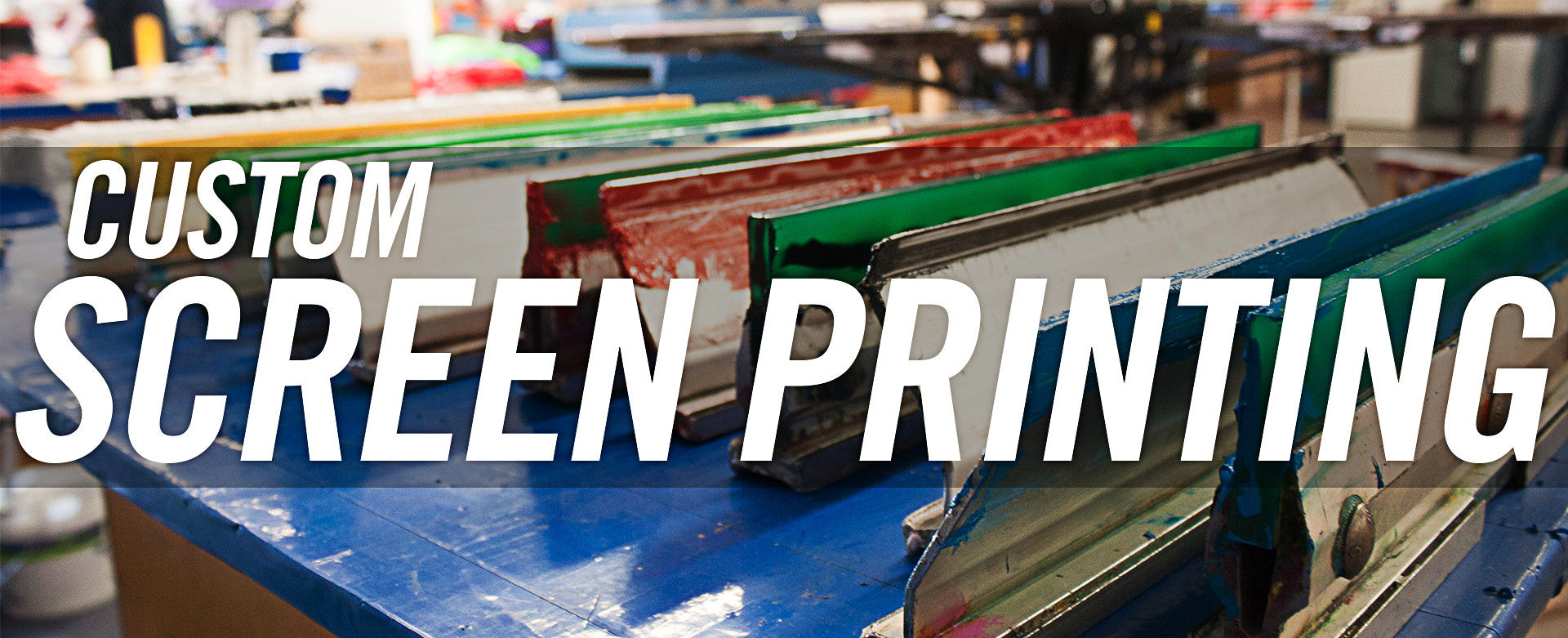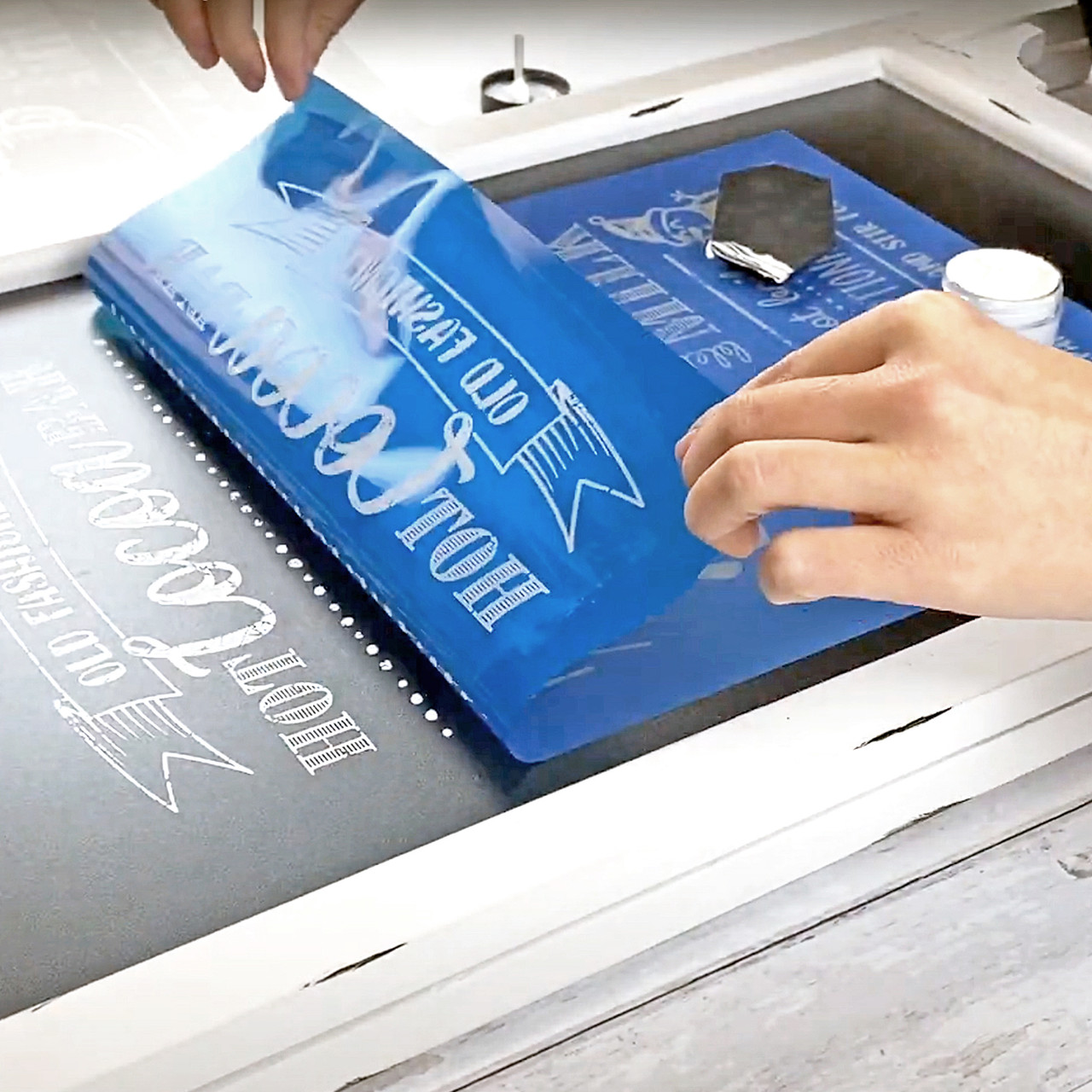Artistic Silk Screen Printing for Limited Edition Prints
Display Printing Uncovered: Every Little Thing You Need to Know Concerning Tee and Garment Printing Techniques
Display printing is an interesting method that integrates art with method, supplying endless possibilities for imagination. Prepared to discover the vital components that make display publishing an art form?
The Essentials of Display Printing: Just How It Functions
When you plunge right into screen printing, you'll find it's both a scientific research and an art. At its core, screen printing includes creating a pattern, or display, that permits ink to go through only in certain areas (screen printing kit). You start by choosing your style and preparing your display with a light-sensitive solution. When you reveal this solution to light, it solidifies, leaving your style as a negative room.
Following, you'll blend your inks and prepare your printing surface. Position the screen over the fabric, then use a squeegee to press ink through the display onto the garment. This process requires accuracy, as you want clear, lively prints. After printing, you'll heal the ink with warm, guaranteeing it abides by the textile and lasts through cleans. Each step is necessary, and understanding them will certainly elevate your display printing abilities, changing basic garments right into one-of-a-kind, expressive pieces.
Sorts Of Display Printing Techniques
Once you grasp the essentials of display printing, it's time to check out the various methods that can raise your styles. One prominent technique is typical screen printing, where ink is pushed through a stenciled screen. This strategy is excellent for strong, dynamic colors. Then there's water-based ink printing, which offers a softer feeling and is environment-friendly, but it requires a various technique to healing.
One more alternative is plastisol printing, understood for its sturdiness and vibrant colors, making it a favored for many brands. Experiment with halftone printing to produce gradient impacts and intricate styles.
Crucial Equipment for Screen Printing
To attain spectacular cause screen printing, having the appropriate tools is essential. You'll require a sturdy display printing framework, which holds the mesh that moves your design onto the garment. Next off, purchase top quality mops; these are essential for applying ink uniformly throughout the display. You'll likewise call for a good exposure unit to produce your screens, as well as a washout cubicle for cleansing them after use. A trusted warm source, like a conveyor dryer or heat press, is critical for treating your prints to ensure durability. Don't forget a correct office, outfitted with tables and storage for your supplies. Protective gear, such as masks and handwear covers, will certainly maintain you risk-free from chemicals and inks. With the right tools, you'll be well on your method to producing professional-quality prints.
Picking the Right Inks and Materials
When selecting inks and materials for screen printing, you need to consider the sort of ink that functions ideal for your job. Think of textile compatibility to assure your styles look excellent and last long. Explore environment-friendly ink options to make your printing process extra sustainable.
Kinds of Screen Inks
Choosing the appropriate screen ink is crucial for attaining vivid, durable prints that meet your task's demands. There are several types of display inks to take a look at. Specialized inks, such as metallic or glow-in-the-dark, can add special results to your styles.

Material Compatibility Considerations
Recognizing textile compatibility is important for achieving high-grade display prints, especially considering that different materials react distinctly to different inks. When selecting inks, think about the material type-- cotton, polyester, or blends. For cotton, water-based inks function well, providing softness and breathability. Polyester, on the other hand, usually needs plastisol inks for better adhesion and lively colors. You might need to utilize a mix of both types if you're printing on blends. Always evaluate your inks on sample material to guarantee they adhere effectively and keep shade stability. In addition, remember that textile weight and structure can influence the last result, so picking the best ink and product combo is important for your job's success.
Eco-Friendly Ink Options
Environmentally friendly inks are coming to be a preferred choice for screen printers who want to reduce their environmental effect while preserving high quality. When selecting inks, consider water-based inks, which are much less dangerous and easier to clean up compared to conventional solvents.
Additionally, look for inks made from sustainable sources, such as soy or vegetable-based alternatives. By selecting the ideal inks and products, you'll not only produce stunning styles yet additionally add to an extra lasting printing process. Make the switch, and your prints will certainly reflect your dedication to the environment!
Preparing Your Layout for Screen Printing

Submit Style Demands
To ensure your design looks vibrant and sharp on textile, you'll require to pay attention to file layout requirements for screen printing. Start with vector files like AI or EPS, as they can be scaled without shedding high quality. If you make use of raster pictures, decide for high-resolution files, such as TIFF or PNG, ideally at 300 DPI. Avoid utilizing JPEGs, as they can shed clarity when resized. Make sure your design has a transparent history to protect against undesirable white sides on your prints. Ultimately, keep shade settings in mind; CMYK is standard for display printing, so transform your RGB makes as necessary. By adhering to these guidelines, you'll establish your art work up for a successful print.
Color Splitting Up Techniques
Color splitting up is a necessary step in preparing your style for display printing, and mastering it can substantially boost your print high quality. You'll require to break your layout right into private colors, as each shade requires a separate screen throughout printing. Begin by determining all the colors in your style and create layers for each one. You can use software like Adobe Photoshop or Illustrator to isolate and separate colors successfully. Be particular to conserve each layer as a separate documents, usually in a style like TIFF or PSD. This precision not just ensures precise color representation but also simplifies the printing process. By taking notice of shade separation, you'll attain vivid and expert lead to your screen-printed garments.
Resolution and Dimension
Attaining the most effective cause display printing begins with ensuring your layout has screen printing kit the best resolution and dimension. Ideally, your artwork must be at the very least 300 DPI (dots per inch) for sharp, clear prints. Your last item may look less than professional and pixelated. if you use lower resolution.
When it pertains to dimension, think about the dimensions of your print area. Layout your artwork to match the last print dimension, preferably producing it in the real dimensions you'll be printing. In this manner, you'll prevent any type of unexpected scaling issues.
Constantly check your style in both vector and raster layouts. Vector graphics can be scaled without shedding top quality, making them suitable for display printing. Preparing correctly will assure your style looks fantastic on every garment!
Step-by-Step Display Printing Process
Screen printing is a dynamic procedure that permits you to develop dynamic designs on numerous surface areas. To get begun, you'll require a display, solution, and your selected ink. Prepare your screen by cleansing it extensively. Next, apply the solution uniformly and allow it dry in a dark location. As soon as dry, subject your display to light with your layout positioned on it, which will set the emulsion where the light hits, creating a pattern - screen printing kit.
Put ink onto the screen and make use of a squeegee to push the ink with the pattern onto the textile. Raise the display very carefully and let the print dry. You've effectively display printed your style.
Tips for Successful Screen Printing Projects
While you're diving right into your screen printing projects, remember that preparation is vital to success. Beginning by collecting all your materials-- inks, mops, displays, and garments. A clean office assists protect against undesirable mistakes, so clean before you start.
Following, validate your art work is high-resolution and correctly sized for your garment. Evaluate your display for appropriate direct exposure and clean it extensively to avoid smudges. When mixing your inks, follow the maker's standards to accomplish the ideal consistency.
Throughout printing, use also pressure with your squeegee for constant results. Don't rush; take your time to confirm each print meets your standards. After printing, let your garments completely dry totally before taking care of or packaging them.
Finally, always keep a sample of your help future reference. By doing this, you can assess your progress and improve your methods with time. Satisfied printing!

Regularly Asked Inquiries
How much time Does It Require To Establish a Display Printing Job?
Establishing a display printing task typically takes about half an hour to an hour. You'll prepare the displays, mix inks, and change journalism. The time varies based on complexity and experience, so remain organized!
Can I Publish on Different Textile Keys In Utilizing the Very Same Method?
Yes, you can publish on various textile kinds making use of the very same technique, but you'll require to adjust your inks and settings. Some textiles absorb ink differently, so trying out guarantees the best outcomes for every product.
What Are Usual Blunders to Prevent in Screen Printing?
When screen printing, prevent typical blunders like making use of the incorrect ink, neglecting correct exposure times, or skipping pre-press checks. Constantly check your arrangement and maintain clean displays to assure top quality outcomes each time.
Exactly How Can I Appropriately Clean and Maintain My Display Printing Devices?
To properly tidy and preserve your screen printing devices, you must routinely clean screens with ideal solvents, check squeegees for wear, and assure all tools are stored dust-free and dry. Consistency boosts and avoids costly repair work performance.
Is Screen Printing Eco-friendly Contrasted to Various Other Approaches?
Screen printing can be more eco-friendly than various other approaches, especially if you utilize water-based inks and eco-conscious materials. By picking lasting products and practices, you reduce waste and lessen your effect on the earth.
Screen Printing Uncovered: Every Little Thing You Required to Know Concerning Tee and Garment Printing Methods
At its core, display printing includes developing a pattern, or display, that allows ink to pass via only in particular areas. Position the display over the material, then use a squeegee to push ink with the display onto the garment. One preferred approach is typical screen printing, where ink is pushed with a stenciled display.When picking inks and materials for screen printing, you need to take right into account the type of ink that functions finest for your job.